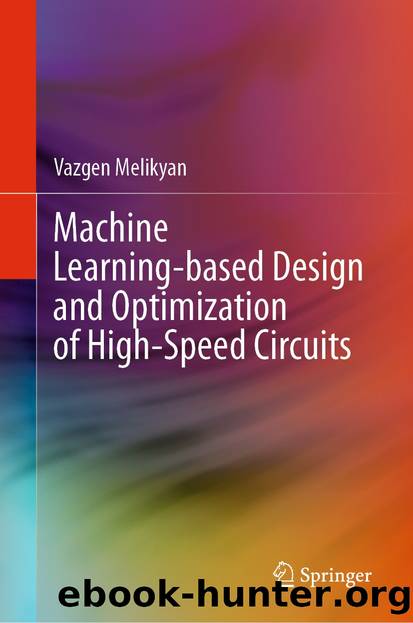Machine Learning-based Design and Optimization of High-Speed Circuits by Vazgen Melikyan

Author:Vazgen Melikyan
Language: eng
Format: epub
ISBN: 9783031507144
Publisher: Springer Nature Switzerland
4.1.5 Causes of Nonlinearity Occurrence in Signalâs Analog-to-Digital Conversion and the Importance and Necessity of Its Reduction in Pipeline ADCs
Another very popular and widely used ADC in modern ICs is the pipeline ADC. It is mainly used in such functions, when the operating frequencies do not exceed 100 MHz. This ADC is slower compared to a flash ADC, but it has a clear advantage in terms of bits. In case of the same area its bit is greater. The simplest pipeline ADC consists of N cascades, each of which receives B bit. In order to obtain a B-bit signal, the input analog signal in each cascade is first selected and stored by a sample-hold (S/H) device, then exposed to coarse quantization (digitization) by means of a sub-range ADC (Fig. 4.13) [47]. The analog voltage is then restored by a sub-DAC, after which the quantized signal is subtracted from the input signal to yield the quantization error. To bring the quantization error to full-scale voltage range, the error is multiplied by 2B â 1 which is performed by OpAmp (Fig. 4.14) [47â50]. The obtained voltage is applied to the input of the next cascade, which has exactly the same structure. Timing and digital correction is done for the obtained B bits by a synchronization and digital error correction device, after which a Y-order digital output corresponding to the input analog signal is obtained.
Fig. 4.13Pipeline ADC block diagram
Download
This site does not store any files on its server. We only index and link to content provided by other sites. Please contact the content providers to delete copyright contents if any and email us, we'll remove relevant links or contents immediately.
Whiskies Galore by Ian Buxton(41937)
Introduction to Aircraft Design (Cambridge Aerospace Series) by John P. Fielding(33092)
Small Unmanned Fixed-wing Aircraft Design by Andrew J. Keane Andras Sobester James P. Scanlan & András Sóbester & James P. Scanlan(32764)
Craft Beer for the Homebrewer by Michael Agnew(18196)
Turbulence by E. J. Noyes(7977)
The Complete Stick Figure Physics Tutorials by Allen Sarah(7338)
Kaplan MCAT General Chemistry Review by Kaplan(6900)
The Thirst by Nesbo Jo(6877)
Bad Blood by John Carreyrou(6581)
Modelling of Convective Heat and Mass Transfer in Rotating Flows by Igor V. Shevchuk(6406)
Learning SQL by Alan Beaulieu(6237)
Weapons of Math Destruction by Cathy O'Neil(6214)
Man-made Catastrophes and Risk Information Concealment by Dmitry Chernov & Didier Sornette(5956)
Digital Minimalism by Cal Newport;(5704)
Life 3.0: Being Human in the Age of Artificial Intelligence by Tegmark Max(5514)
iGen by Jean M. Twenge(5385)
Secrets of Antigravity Propulsion: Tesla, UFOs, and Classified Aerospace Technology by Ph.D. Paul A. Laviolette(5333)
Design of Trajectory Optimization Approach for Space Maneuver Vehicle Skip Entry Problems by Runqi Chai & Al Savvaris & Antonios Tsourdos & Senchun Chai(5037)
Pale Blue Dot by Carl Sagan(4953)
